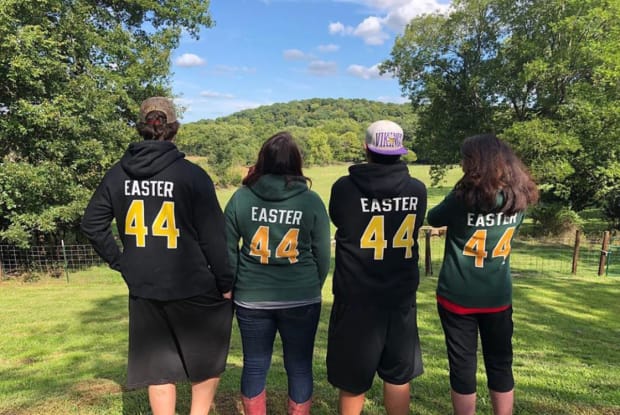It has been almost five years since 24-year-old Zac Easter took his life, blaming his own rapid demise on football-related concussions. Those closest to Zac have had to reassess their relationships with the game—but change is a tricky thing.
From Love, Zac: Small-Town Football and the Life and Death of an American Boy, by Reid Forgrave ©2020 by Reid Forgrave. Reprinted by permission of Algonquin Books of Chapel Hill. All rights reserved.
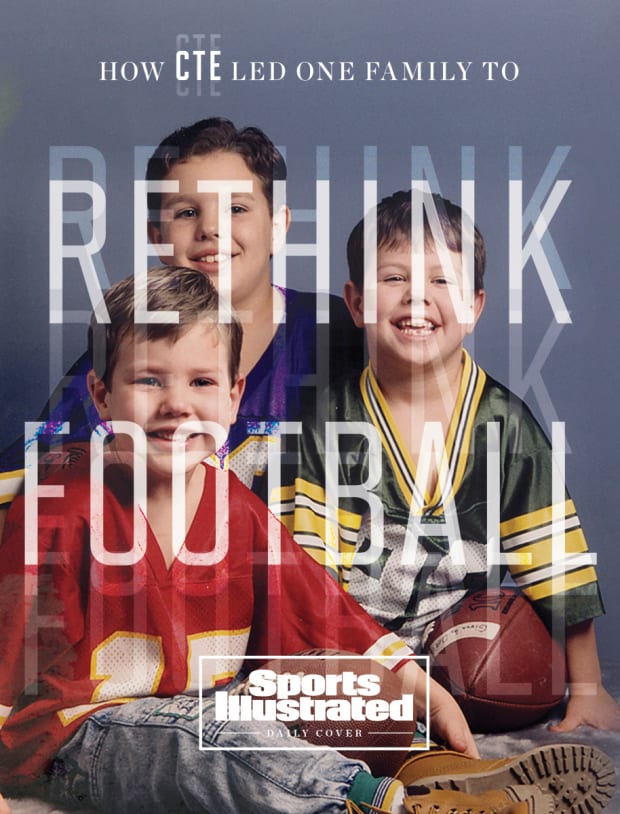
Zac Easter had printed off the 39-page, double-spaced Microsoft Word document and left it in his room, by his desk, before he went to the basement to retrieve the shotgun slug. Titled “Concussions: My Silent Struggle,” his brief autobiography detailed how football concussions had led to his demise—to substance use, to mental health issues, to his later taking his own life with a bullet to the chest, on Dec. 19, 2015. (His handwritten journals were stashed nearby in a file box.) After getting his story down, he’d gone back to the beginning of the document and inserted a preamble of sorts:
My last wishes
It’s taken me about 5 months to write all of this. Sorry for the bad grammar in a lot of spots. (Editor's note: Zac’s often-haphazard spelling is retained when quoting from his diary.)
I WANT MY BRAIN DONATED TO THE BRAIN BANK!! I WANT MY BRAIN DONATED TO THE SPORTS LEGACY INSTITUE A.K.A THE CONCUSSION FOUNDATION. If you go to the concussion foundation website you can see where there is a spot for donatation. I want my brain donated because I don’t know what happened to me and I know the concussions had something to do with it.
Please please please give me the cheapest burial possible. I don’t want anything fancy and I want to be cremated. Once cremated, I want my ashes spread in the timber on the side hill where I shot my 10-point buck. That is where I was happiest and that is where I want to lay. Feel free to spread my ashes around the timber if you’d like, but just remember on the side hill is where I would like most of my remains. I am truly sorry if I put you in a financial burden. I just can’t live with this pain any more.
I don’t want anything expensive at my funeral or whatever it is. Please please please I beg you to choose the cheapest route and not even buy me a burial plot at a cemetary. It is what I, Zac Easter, WANTS!!
I also do not want a military funeral. If there are color guardsmen or anyone else at my funerial or whatever you have I will haunt you forever. I DO NOT WANT A MILITARY FUNERAL. I DON’T WANT THE MILITATRY ENVOVLED AT ALL. F--- the army and f--- the government. ...
You will have to turn in my military equipment, though. That is in the trunk of my car in a green army duffle bag and stuff in Levi’s room like my uniforms. … Please tell them my story.
Levi gets my car; it will need an oil change and breaks/tires done shortly. Please take care of old red. It will need to be cleaned out as well because I am a slob.
Thank you for being the best family in the world. I will watch over you all and please take my last wishes into consideration. Do not do something I do no want. Just remember, I don’t want a military funeral like Grandpa’s. It is my last wish and last rights.
I am with the Lord now.
Look, I’m sorry, everyone, for the choice I made. It’s wrong and we all know it.

***
Family and friends gathered at the Easter household that night, in the timber and corn fields just miles from where Zac’s hardscrabble ancestors had settled in Iowa, not long before the Civil War. They stayed almost until sunrise. They cried. They hugged. Zac’s older brother punched a hole in a wall.
For much of the next 48 hours, Zac’s dad stood outside in the cold. He didn’t want to talk to anyone. Regret was almost suffocating him; he was the hard-ass football coach who had pushed his three sons toward this sport. Now his middle son was dead, and he had at least partially blamed football for his demise. Myles Easter Sr. would pick up his son’s autobiography just once, shortly after his death. He read through the entire thing, trying to understand what had happened to his son’s tortured mind. Standing out in the cold, he was numb. As family and friends gathered in the Easters’ home outside the small town of Indianola, Iowa, to share in their grief, not many came up to talk with the boy’s father. “Nobody,” Myles recalled later, “knew what the hell to say.”
***
Four days later, Eric Kluver, the football coach at Indianola High, stood over his former player’s casket. Inside was the body of the young man who represented everything Kluver loved about football, the wild child who for two summers had put in some good, honest work alongside him in the sweltering Iowa heat for Kluver’s landscaping business. Later, Kluver would pin photographs from Zac’s funeral to the walls of his basement. He didn’t want to forget the feeling of guilt, that maybe he had helped create this moment.
Did football do this? he wondered. Did I do this? He and his staff had always taught Zac proper tackling technique, but they’d never insisted that he scale back his aggression. If anything, that aggression—the feeling that Zac would sacrifice his own body for the good of the team—made him an easy role model for younger players. Zac’s body might not have been the ideal football body, but his mentality—his mind—was the archetype: the hard-nosed player every football coach dreams of.
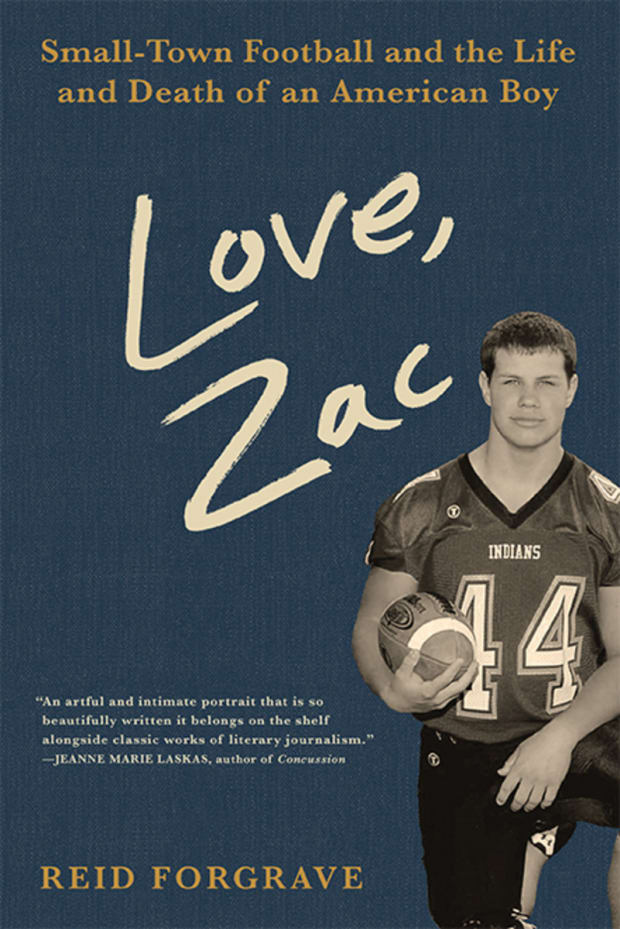
Preorder Love, Zac: Small-Town Football and the Life and Death of an American Boy
And yet his story became the superhero movie that ends in tragedy. Zac Easter’s greatest strength turned out to be his greatest weakness.
Kluver knew football played a role in Zac’s destruction—football, and the culture around America’s favorite sport. He could compartmentalize the other two life-altering football injuries from his past—to one of his own high school teammates, and to one of Zac’s old high school teammates—as freak brain injuries that happened to occur on a football field. But Zac? This was from football, from the way Zac played the sport for nearly half his life. It was like the old dilemma from football’s earliest days: unnecessary roughness versus necessary roughness. The violence that’s outside the bounds of the game’s propriety versus the violence that this game glorifies. Zac’s injury felt like, quite simply, part of the game—at least the old-fashioned, hard-hitting, devil-may-care way that Zac played the game.
“To see him lying in that casket,” Kluver said later, “you would think that would be enough to make you say ‘enough is enough.’ It almost makes me sick to keep doing what I’m doing.”
And yet, months after saying this, Kluver would lead his team out of the sparkling new locker room at Indianola High for its first game of the new season. In the hallways of the school, he would still see the occasional BIG HAMMER T-shirt worn by the younger brother of a player who had earned one many years ago, before Kluver stopped handing them out to reward the most bone-crunching hits.
Despite everything, Kluver still believes in football. He believes more good comes from the sport than does bad. Far more good. He believes life is full of risks, and that we should not pad our children in Bubble Wrap. Boys must be boys. But his faith in football is rattled. When I told him that Zac wrote in parts of his journal that he wished he had never played football, Kluver squeezed his eyes shut and put a hand to his forehead.
“There’s definitely been times where I’ve asked, ‘Is this worth it?’ ” the coach said.
What Kluver was debating inside his own mind parallels perhaps the defining question of this era in American sports: Is football worth it? Or, to put a finer point on it: What are we willing to sacrifice as a society to keep our beloved national sport recognizable as the same one we have enjoyed—the sport that has helped shape us as a country—for more than a century? If 10% of NFL players end up with shortened lives, and with lower quality of life, due to brain injuries sustained by playing the sport, is that an acceptably low number for us to continue as unabated, unabashed fans? What if that number is 25%? Or 50%? (The best guesses using current science indicate that somewhere between 5% and 8% of former NFL players die with brain disease, a much higher rate than the normal population.) And how does that determination change when we talk about collegiate players, who are paid not in the millions of dollars but in scholarships that cover tuition and room and board?
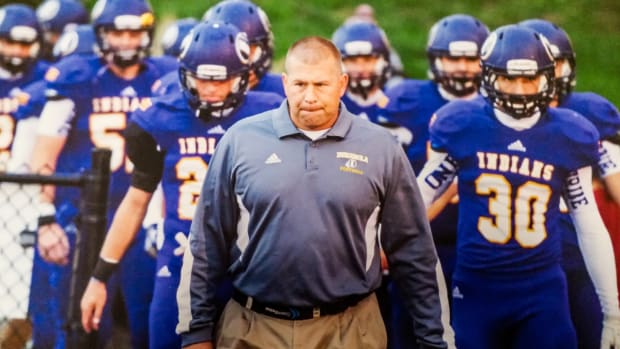
It is one thing when old football warriors suffer from bad knees and constant joint pain; every football player since the sport’s beginning has known these pains later in life were the price of admission. But the idea that this sport could severely damage the brain, the ability to reason—the very thing that makes us human—changes the equation, making it something closer to an existential crisis.
Another, more complicated part of the equation: What about the Zac Easters of our world? What level of risk are we willing to take on as a society when we are talking about the ways that football hurts high school standouts who’ll never advance to the highest levels of this sport? For a teenager with zero shot at the pros, someone who goes into sports for the fun and the camaraderie and maybe even the life lessons, is playing on a football team really a much better life experience than playing a sport with a lower chance of permanent brain trauma, like basketball or baseball or track? Bennet Omalu, the neuropathologist who helped bring CTE to the public consciousness, zeroes in on this point. He has become a controversial figure in scientific circles for many reasons, in part because his research has segued into what often feels like a campaign against youth contact sports. He does not blame the NFL for the current concussion crisis. But his solution for how society should wrestle with this is as simple and practical as it is threatening to football’s existence, and he argues it with an evangelical fervor.
Omalu compares football with smoking. Both are dangerous, and both are things that some humans enjoy. So, he proposes, make tackle football like smoking—something American men are only permitted to do after they turn 18. This would protect the Zac Easters of the world from any sort of brain trauma related to youth or high school football, and would also limit the years that a college or professional football player is exposed to repetitive hits to the head. But this solution likely would also dry out the talent pool for college football and the NFL. I think it’s fair to assume that a ban on tackle football for anyone younger than 18 would, within a couple of generations, cause the marginalization, or even extinction, of college and professional football.
“What Zac’s case tells us,” Omalu says, “is that parents need to know that when you put a helmet on your son’s head and send him out to play football, there is a risk of your child suffering permanent brain damage. The truth is inconvenient. The truth could be painful. This is a game people love. But as a society we evolve. And as we evolve we become more intelligent, and as we become more intelligent we give up the less intelligent ways of the past. Knowing what we know today, there is no justification for children under the age of 18 to engage in high-impact contact sports.”
Which for Eric Kluver makes perfect sense, theoretically. But emotionally, the solution is not so simple. Take away football from these high school boys, and we as a nation lose something important that’s shaped generations of American men.
In the wake of Zac’s death, Kluver has changed the way he coaches. He has drastically decreased the amount of contact in his practices. His coaches now teach Hawk tackling, a rugby-style take-down popularized by Seattle Seahawks coach Pete Carroll that involves taking the head out of the impact of the tackle (as opposed to previous styles of tackling, where players were taught to get their head out in front). Players are taught to lead with their shoulder, and to avoid slamming their face mask into the ball carrier. In preseason meetings with parents, Kluver stresses the importance of taking concussions seriously and tells them that any player with a suspected concussion will go through a concussion protocol. “People know Zac’s story,” Kluver said. “It’s the elephant in the room.”
The other elephant in the room: Football is violent. It just is. Millions of American boys and young men aren’t suddenly going to trade in the cathartic violence of tackle football for the simulacrum that is flag football. The love for the sport would disappear in a flag football world. So, instead of the Omalu solution, football tries to improve incrementally, to get safer on the margins while retaining the core element of physical danger and risk that has always been central to its appeal. Danger and risk are not a bug of football; they are central tenets for America’s favorite sport.
“No matter how you slice it, it’s going to be a contact sport,” Kluver said. “I don’t know how you change the game while still keeping it similar.”
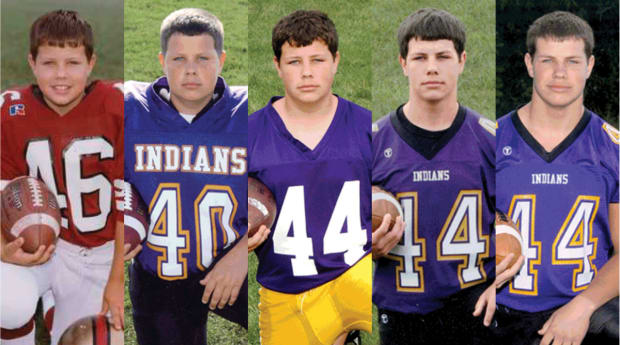
***
Two weeks after Zac turned the shotgun on himself and pulled the trigger, I met the Easter family for the first time in person, having spoken to Zac’s mother, Brenda, by phone a few days earlier. In the living room—with Zac’s 10-point buck mounted on the wall, hovering over us—Zac’s father; his mother; his older brother; his girlfriend, Ali Epperson; and his old high school football trainer sat with me in a semicircle. We spoke for almost four hours. There were not many tears, in part because the family was still in shock, and in part because they now had a charge.
In the writings he left behind, Zac gave his family and friends clear instructions: They should not let his death be in vain. His family framed his suicide not as the ultimate selfish act but as something very different: as a sacrifice that meant his death could take on a greater meaning, and could be used to help others like him. So the family moved quickly from the stasis of mourning into actually doing something. Starting a foundation in his honor. Speaking to football players about the risks of concussions. Pushing the NFL to take those risks more seriously. Raising money and awareness for research into concussions and CTE. Anything to give a sense of meaning to Zac’s senseless death.
How did they feel about football, and the sport’s future? Well, it’s complicated. Brenda Easter—who had winced back in college when her future husband got into on-field collisions playing Division-I football at Drake University, and who later cringed whenever her three sons were involved in crunching hits on the gridiron—was done with the sport. She would put up with it on the television in the living room because this sport was so ingrained in her family’s consciousness and history. But there was zero chance that her grandchildren would play. They could play basketball or baseball or run track instead.
“There was a time when football was instilled in everybody in society,” Brenda told me. “In the small towns, that’s all they had to do. Football Friday nights is the thing to do. But does that mean that it can’t be changed? That something else safer can’t replace it?” Her feelings about football, especially amongst kids, would only harden with time, and with more research. Like when she learned about a Harvard study that showed the average white American male lives to age 78, and the average Black American male lives to 70, but the average professional football player in both the U.S. and Canada lives to just his mid- to late 50s. Or when she learned about another study—commissioned by the NFL, right around the time Zac was a high school senior, and conducted by the University of Michigan’s Institute for Social Research—that reported Alzheimer’s disease and similar memory-related diseases appeared among NFL retirees at 19 times the normal rate for men ages 30 to 49. The answer to all this, to her, felt obvious: Less football would mean safer children.
On a summer night a couple of years after Zac’s death, after I had gotten to know the family quite well, I sat at the Easters’ kitchen table with Brenda and Myles for hours, drinking beer and talking about Zac and about football. At one point, when I kept pressing Brenda on how she feels about football today, and if the lessons learned from football outweigh the risks of the sport, Brenda lost her temper with me. “I get angry every day,” she told me. “You asked me, ‘Do I hate football?’ I don’t hate football. I get angry that the thing that everybody loves is so dangerous. Do I hate the sport? It’s a struggle. Because I want to hate the sport so bad. Because it took my son. But I can't. Because I know how much Zac loved it. I know how much all the boys and the fans love it. What I wish is that we could figure out today how to protect them so they can continue to do what they love. The fact that I can't protect them, despite knowing what I know today, makes me ill.”
For Myles Easter, the guilt was overwhelming. He had pushed his three sons to play the sport, and now the middle one was gone because of it. Yet, decades of playing and coaching and watching a specific version of football—the old-school version that exalted the Easter mentality—had formed so much of who Myles Easter was. He still didn’t want football to change too much; it was the sport that had forged men from boys.
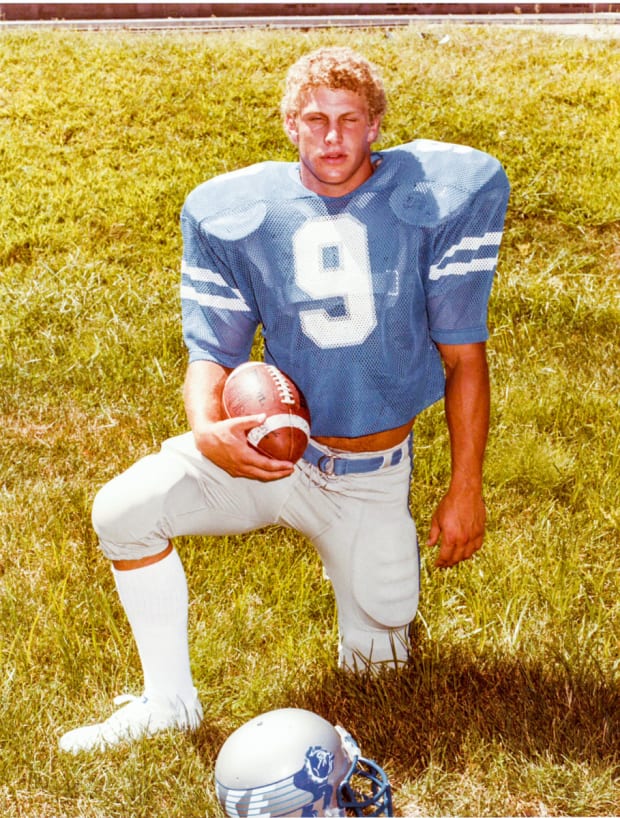
This has been a common reaction as long as people have tried to reform the violence out of football. After a 1931 report by the Carnegie Foundation predicted touch football would replace tackle football, Lone Star Dietz, a former teammate of Jim Thorpe’s (and then the football coach at Haskell Institute), responded angrily: “They’re trying to make a sissy game out of football.” Even after all Myles Easter had been through, that’s still how he ultimately felt about his beloved game of football. All these new rules were weakening the sport. He missed the old days. More accurately, though, he missed the naive days, when you could play football and coach football and watch football without knowing exactly what those hits to the head were doing to the players’ brains.
Ali, Zac’s girlfriend, still recognized how much Zac had adored the sport. But in her mind, football would forever be the thing that killed him and changed the trajectory of her life. "I have such a complicated relationship with football,” she said. “I feel conflicted. I understand the benefits, and why people love it, but I also know so much needs to change. It's the sport that contributed to my boyfriend’s death. What do you do from there?”
In the years after his death, Ali would throw herself into fundraising for scientific research to protect athletes—especially youth athletes—from going down the same road as Zac. She would make frequent visits to the cemetery—the one wish of Zac’s that wasn’t followed. She would bring flowers and a Monster Energy drink, Zac’s favorite, and just sit by his memorial headstone and talk with him.
As we spoke in the Easters’ living room just weeks after Zac’s death, the television was on mute, tuned to the Vikings and Packers. Huge game. Bitter rivals, the NFC North title on the line. As we spoke about Zac’s zest for life and the struggles that led to his death, the men in the house, myself included, kept peeking at our phones. We were checking our fantasy-football scores.
***
Zac left instructions: Print his story off his laptop, post it to Facebook, use the pain of his life and too-early death to warn the world about CTE. Get people like us—football fans, football players, football parents, football lifers—to face the truth about people like him. And his family did all that, and continues to, through their nonprofit foundation, CTE Hope, dedicated to aiding scientific research to limit and prevent concussions in sports.
Ali continues to be a driving force for the foundation, as does Sue Wilson, the trainer at Indianola High. After graduating magna cum laude from law school and being named a national law student of the year by National Jurist, Ali took a job at a corporate law firm in New York City. She’s doing the type of high-powered legal work—in her firm’s white-collar, investigations, securities litigation, and compliance group—that Zac expected from her. On the side, she coordinates CTE Hope’s communications, returning to Iowa each year to organize a spring gala.
Sue Wilson got a taste of public service as vice president of Iowa’s Advisory Council on Brain Injury; in that capacity, she helped develop a brain-injury screening tool for places like jails and homeless shelters to determine whether specific mental health issues might trace back to a previous brain injury. Sue then decided to run for a spot on the Indianola School Board, on a platform of addressing students’ mental health issues. And she won. The woman who a dozen years ago was an unwelcome feminine sight on the Indianola Indians’ sidelines has since gained an outsize voice in the community. As one of the cofounders of CTE Hope, Sue spearheaded a research partnership with Myles’s alma mater, Drake University, which is helping develop treatment protocols for people suffering from early symptoms of CTE. The school is also starting a brain injury curriculum in its health sciences department. The classes are geared toward those studying pharmacy, physical therapy, occupational therapy, and athletic training. Sue will be an adjunct professor.
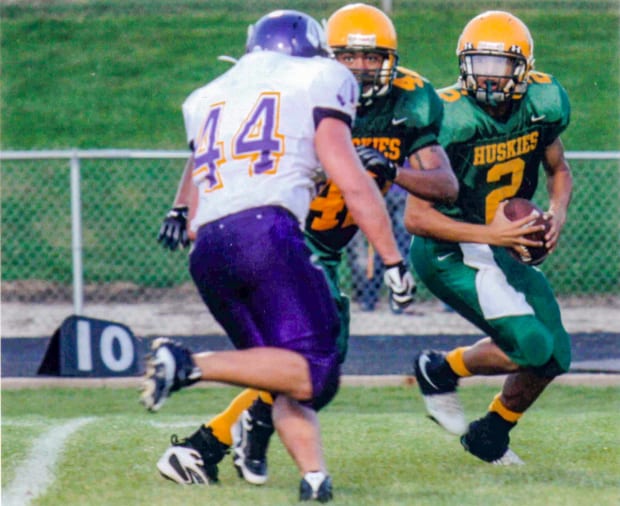
If Zac were around, he’d see how his family, his girlfriend and his friends followed his instructions. They advocated for legislation for Iowa high schools to update their post-concussion return-to-play protocol, which was signed by the governor a couple of years after Zac’s death. They are also advocating for more controversial nationwide legislation to eliminate tackle football before age 14, when a young and developing brain is most susceptible to traumatic brain injury. The foundation launched a saliva research study, which has collected some 4,000 samples from football and soccer players statewide and sent them to a lab at Harvard Medical School. The aim: to measure inflammatory markers and proteins associated with head trauma, with a goal of developing a device, similar to a pregnancy test or a blood-sugar testing device, that can immediately identify a concussion. Zac’s family has followed his instructions to a T.
Although he doesn’t know the Easter family and hasn’t been active in the foundation, Shawn Spooner—a U.S. Navy veteran and sports medicine doctor who treated Zac for the damage wrought by his concussions—has, in his own way, followed Zac’s instructions as well. Inspired by Zac and a few other patients who struggled to find timely, quality, concussion-related care, he pushed his health-care provider, UnityPoint Health, to build a new facility focused largely on concussions. It’s the same model Spooner worked with in Afghanistan, with a large interdisciplinary team—a sports neuropsychologist and a specialty physician, a speech-language pathologist and an athletic trainer and several physical therapists—all under one roof.
But Zac’s instructions left no guidance about how to mourn, and no guidance about how we should think about our national sport. So now what?
We could ban football. (But we love football.) We could allow people to play only once they turn 18, as Omalu has proposed. (But what happens when 18-year-old athletic phenoms—freight trains who have never learned to tackle properly—are suddenly turned loose on one another? Would that be better?) We could take away tackling. (Sorry, no one’s watching the National Flag Football League.) We could build a safer helmet. (Which, some argue, would only encourage players to use their heads as weapons.) We could develop a consistent concussion protocol through all levels of football. (We already have that in the NFL.)
Every solution ends up not solving enough of the problem.
And for most of us, this is perfectly O.K. The paradox of CTE’s discovery is that it has given most of us a sneaky, ethical out, hasn’t it? No professional football player can claim now to be unaware of the risks. It’s a free country. We’re all adults here.
Unless we’re not adults.
Unless we’re kids.
Unless we’re Zac.
***
The email arrived in Brenda Easter’s Hotmail inbox at 5:33 p.m. on Tuesday, May 24, 2016—five months after Zac had died. The correspondence came from Bennet Omalu. Shortly after Zac’s death, Brenda had shipped his brain to Omalu’s old forensic neuropathology lab in Pittsburgh, the same lab that studied Mike Webster’s brain. Pathologists then cut Zac’s brain into paper-thin slices, put them on slides and used special chemicals to study whether the buildup of tau proteins in Zac’s brain indicated he had CTE.
“Brain Report,” Omalu’s subject line read. Attached was a PDF document: Zachary Easter, Brain Forensic Neuropathology Report.
That document was completed by a pathologist named Julia Kofler and contained plenty of basic details. That Zac had died by suicide in December 2015. That he had played football from age nine until 18 and sustained multiple confirmed concussions from playing. That his brain weighed 1,540 grams. But right there on the first page of the report, the CTE diagnosis that Zac had feared was confirmed. Tau protein buildup was “widespread” in his brain. The report cited multiple concussions from football as a potential cause.
Zac was right. The brain disease that had felled famous football players like 17-year NFL veteran Mike Webster, or 20-year NFL veteran Junior Seau had, somehow, crept into Zac’s brain by the time he was just 24. To his parents, the diagnosis brought conflicting emotions. First, it felt impossible. Sure, he was a reckless player, but Zac hadn’t even played football past high school.
But the diagnosis also felt strangely comforting. Zac was right all along. If neuropathologists had looked at his brain and seen nothing out of order, his parents would have been doubly devastated. There wouldn’t have been an explanation for his death that made any sense. Now, at the very least, they could say they knew what their son was experiencing. The email brought the family a peculiar type of relief.
***
Can you imagine football just … going away?
No more feelings of anticipation as the long days of summer start to wane, as training camps kick off, as football openers loom, right around the corner. No more autumn tableaus of Americana where preteens play raucous, helmetless games of tackle football in yards covered with leaves. No more Thanksgivings spent gathered around the television to watch the Dallas Cowboys or the Detroit Lions. No more Friday night lights, no more Saturday morning tailgates, no more Sundays blanketed with NFL games, no more Monday Night Football. A new era in which America simply can no longer stomach the repercussions of this sport.
No more football? No way. Americans have a remarkable capability to compartmentalize our morality. To convince ourselves that, sure, this sport has obvious negative side effects, and those negative side effects are far greater than we’d ever imagined—but ultimately decide that we love it anyway. “That’s what the NFL is banking on these next few years—hypocrisy, basically—as more stories emerge about the tortured lives of retired players,” sportswriter Bill Simmons wrote in the wake of the NFL’s Bountygate scandal, with New Orleans Saints coaches accused of paying out cash bonuses to their players for injuring opponents. “You hear these things, you sigh, you feel remorse, you forget … and then you go back to looking forward to the next football season.”
I don’t say all this as some self-righteous tut-tutter of America’s football hypocrisy but instead as a full-blown participant in it. I’m still a hardcore NFL fan. Even as I write about how football played a role in Zac Easter’s death, as I interview family members of others who died by suicide after suffering from football-induced CTE, as I nod in agreement when my wife says there’s zero chance our two young sons, Owen and Lincoln, will ever play the sport—I still watch.
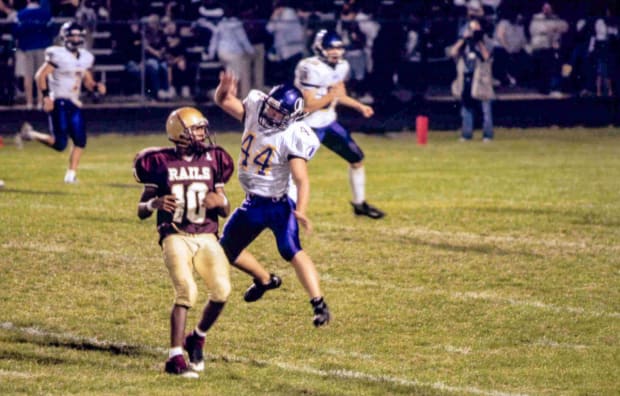
And it’s not some sick addiction that I hide from my family. I wear it proudly, looking forward to watching NFL games on Sundays alongside my rambunctious three-year-old. Like Zac, he is joyous and kind, devious and destructive. “FOOTBAAALL!” Lincoln will scream at me, then try to bowl me over. We’ve nicknamed him Lincoln the Marauder. It’s only a matter of time before these theoretical discussions about football become very real, when all of Lincoln’s friends are suiting up for the team and he wants to suit up, too.
Omalu diagnoses America’s inability to rationally think about football’s future as cognitive dissonance: Our views are shaped by societal expectations and traditions, and we simply ignore evidence that goes against those long-held beliefs. “God did not intend for us to play football,” Omalu told me. “Nature, our human bodies, did not intend for us to expose our heads to repeated blunt force trauma … Your child, I guarantee you, has some degree of brain damage if he plays this game for a length of time.”
It’s a moral problem, yes. But it’s a business problem, too; football is a big business. Billionaire owners of NFL teams, major American universities that have staked their public reputations on the sport, small towns that have made shrine-like high school football stadiums among the most important pieces of infrastructure in their town … We’re all invested. The sport’s tentacles go deep.
“It is possible that football will grow less popular in this country,” Steve Almond writes in his book, Against Football: One Fan’s Reluctant Manifesto. “Here’s how it might happen: First, several retired stars might reveal the depth of their neurological impairment. Steve Young on 60 Minutes. Brett Favre weeping to Oprah. Second, the safer equipment and rules that fans are forever touting as silver bullets may do little to alter the brutal physics of the game. Third, medical technology inevitably will make visible the damage done to young men who play the sport. Fourth, a major college or pro player might be paralyzed or killed during a game. Fifth, a successful class-action suit at the high school or college level could trigger a domino effect.”
***
Myles Easter can remember, as a kid in the 1960s and ’70s, gathering around the television to watch boxing matches with his father. When Myles’s father was growing up, boxing was considered one of our top national sports, “a symbol of American sport,” according to a 1944 article in The Journal of Health and Physical Education.
But Myles never watched boxing matches with his own sons, perhaps because our society came to deem boxing too primitive, too dangerous, and we lost our collective stomach for it. Boxing still exists, of course, but only as a niche sport. There used to be boxing clubs all over American high schools and colleges. Now, those are few and far between. One of the watershed moments of the sport’s fall from grace came in 1982, when Howard Cosell, an ABC sportscaster and one of the foremost faces of American boxing for a quarter century, witnessed Larry Holmes beat down Tex Cobb in a bloody, lopsided fight. A couple of weeks earlier, Ray Mancini had beat down Kim Duk-Koo in another bloody, lopsided (and nationally televised) fight, which led to Kim’s death from brain injuries. Cosell was disgusted; he vowed after the Holmes fight to never call another professional match. “I’ve had it,” Cosell told The New York Times. “I now favor the abolition of professional boxing.”
There have been plenty of ex-football players to offer similar critiques of their sport. Americans have mostly shrugged them off. Ed Cunningham, a former NFL player who later served as a college football analyst for ESPN and ABC, resigned in 2017 because of his concerns about the sport. Plenty of high-profile NFL players have retired early because of concerns about brain trauma. Perhaps, though, that rejection of football by people who are intimately in its orbit will, in time, reach some sort of tipping point.
“Maybe [football is] popular because it’s the one huge cultural space where we can safely indulge all the s--- we haven’t worked out yet as a people: our lust for violence, our racial neuroses, our yearning for patriarchal dominion, our sexual hang-ups,” Almond writes in his book. “It’s the place where men get to be boys—before the age of reason, before the age of guilt.”
But today, as a society, we’re in the age of reason, in the age of guilt. We can no longer plead ignorance that we simply didn’t know what all those hits to the head could do to the human brain. Now, we know. We are no longer innocent bystanders but active participants, complicit in whatever damage football brings. We look back at those old NFL films—NFL’s Greatest Hits or Big Blocks and King Size Hits or Crunch Course or Thunder and Destruction—as stuff of a prior age. We look back at the old introduction to Monday Night Football, with two helmets ramming into each other and exploding, as an unenlightened form of this sport. We cringe when we think about the old ESPN segment, “Jacked Up.” We realize that handing out a BIG HAMMER T-shirt to a high school student to celebrate a punishing hit probably is not the best practice. We punish the NFL coach for paying his defensive players $1,500 apiece for hits that resulted in opponents being knocked out. “Kill the head, the body will die!” Saints defensive coordinator Gregg Williams would tell his players. But then, after being suspended for one season, we welcome that coach back into the league.
We think that we have reformed football. We say that football is safer now than it ever has been. But do we really know how true that is?
There are only two morally upstanding ways to approach the concerns we have about football as our national sport: Devote every resource we have to making it as safe as possible when it comes to brain injuries. Or renounce the sport completely.
They say that you must hit rock bottom before you renounce your addiction. What would the bottom look like for a nation addicted to football? Perhaps it could be something public and dramatic, like a player dying from a massive hit during a nationally televised game. Or it could be something more mundane, like a credible lab test that can use biomarkers to diagnose the onset of CTE in living brain tissue and show an exact percentage of American high school football players who already have incipient CTE.
Think about Myles Easter’s all-time favorite player, Jack Tatum. The Assassin. When a hit by Tatum paralyzed Darryl Stingley in 1978, that could be compartmentalized by the average American football fan. This was a freak hit: unnecessary roughness, not a natural part of the game. These types of hits can be legislated out of the sport, and that’s exactly what the NFL and every lower form of football has attempted to do. But what if, like many scientists posit, it may not be those huge, bone-rattling hits that are the primary precursor for CTE but the multiple subconcussive hits that occur hundreds of times during every NFL game (and every college game, and every high school game)? Those hits are necessary roughness, a routine by-product of how the game is played. An improved concussion protocol won’t make a difference for the cases of CTE that stem from years of repeated subconcussive hits.
While the notion of football being ostracized by society is today mocked as an idea of the effete, liberal, nanny-state crowd, the social pressures to stop smoking or to wear seat belts were once mocked in much the same way, too. The day may come when parents would be equally as apt to let their children play football as they are to allow their youngest to ride in a car without a car seat.
But we love violence, right? What if football is recognized as so dangerous that the vast majority of parents won’t allow their sons to play, and it becomes our equivalent of gladiatorial combat, only engaged in by the poor and people without options? America’s have-nots, going out to the gridiron and destroying themselves for the pleasure of America’s haves. Football could become the forbidden fruit, the sport so many are afraid to play—and, perhaps, the game would become even more violent in response. In ancient Rome, gladiators were seen as human sacrifices.
Echoes of those gladiators can be heard in the words of former Pittsburgh Steelers running back Rashard Mendenhall, who in 2014 said No thanks to millions more dollars and retired from football at age 26. “I no longer wish to put my body at risk,” he said, “for the sake of entertainment.”
So is football worth it? It may be the most important question of our American sporting time. And it’s a question without a clean answer.
Perhaps the story of Zac Easter can lead us to the most appropriate way to look at football. Zac knew he had CTE. He knew before the doctors did. And he blamed football, and the concussions he suffered while playing the sport. At times, he hated everything about the sport. At times, though, he loved the sport as much as just about anything in his life. Even after knowing what the sport (and his approach to the sport) had done to his brain, even after the very public suicide attempt that landed him in the psych ward, there Zac was, sitting in his parents’ basement on Thanksgiving night, watching his beloved Green Bay Packers.
Football is awful, a sport that brings out the very worst violent tendencies in the human species, and that destroys us in the process.
Football is great, the one true sport, teaching us how to deal with physical pain without being utterly defeated by it, all the while forging the true American male.
Football is a dangerous, vile sport. Football is a beautiful, cathartic sport.
Football, perhaps, is both.
***
One week after Zac’s death, on Ali’s 23rd birthday, Brenda Easter handed Ali an envelope. Inside was $1,400—the money from Zac’s final paycheck for a landscaping job. He had left instructions that it go to Ali. Zac hadn’t been working for a while, so this underscored to Ali just how purposeful his suicide had been—that he’d been planning it for a long time.
In the months after his death, Ali began to think of herself as a widow; even though they hadn’t been married, they’d been best friends for five years and had dated off and on during that entire period, so labeling herself as a widow felt morbidly appropriate. Ali went to a jewelry store and designed a ring. It had five stones. Two were pearls, Zac’s birthstone; and three were blue sapphires, their shared favorite color. On the inside of the ring was inscribed, Z+W, for Zac+Winslow (Ali’s middle name, which Zac used as a pet name for her). She thought of it as their wedding ring of sorts. They’d been planning to spend their lives together. The ring represented what could have been.

For Christmas in 2016, one year after Zac’s death, Ali made some presents for Zac’s parents and brothers—picture frames engraved with Zac’s handwriting, plus personalized football sweatshirts for each of them: Vikings for Myles Sr. and Myles II, Chiefs for Levi, and Packers for Brenda. The back of each sweatshirt read EASTER, with Zac’s old football number, 44.
After buying her ring, Ali still had some of Zac’s money left over. So on December 23, 2016, when she was home for winter break of her second year in law school, she and Jake Powers, Zac’s old friend and roommate, got in Jake’s truck at the crack of dawn and drove east. They passed through the cornfields of Iowa, crossed the Mississippi River at Dubuque, headed northeast through Wisconsin, and came to a halt seven hours later in Green Bay, for the Packers’ final home game of the regular season. For Ali, it was a trip full of complicated emotions. Lambeau Field was one of Zac’s favorite places on Earth, a cathedral of football. He’d been there only once, in December ’14, and came back from that trip inspired to turn it into an annual tradition with Jake. Ali wanted to be there in Zac’s place, even if that meant paying homage to the sport that had contributed to his destruction.
The next day, on Christmas Eve, Ali and Jake went to Lambeau, first to the massive tailgate and then to the game. Ali wore a Packers sweatshirt with Zac’s name and number on the back, and Zac’s old Green Bay knit cap.
Her feelings about football are nuanced. She recognizes that it brings people together, that is has many positive influences in people’s lives. But she is angry that football—that the NFL—took so long to recognize the damage the sport can cause. That disregard felt like a betrayal of the very people the game employs and entertains. Still, Ali wanted to see Lambeau, and she wanted to cheer on the Packers in place of Zac, even if that meant honoring the thing she believes killed him. If Zac had lived, he would have been here with her. So she yelled wildly as the Packers beat the Vikings, 38–25, and eliminated their archrivals from the playoff race. It was easy to get lost in the excitement, in the tradition, in the history, even if every time a player endured a hard hit to the head, Ali winced.
This, she felt, was the way Zac would have wanted to be honored. Yes, he had grown to hate what football had done to him. But the sport was such a big part of his life: being a man whose character was formed through football, having heroes, believing in something. Ali thought these football pilgrimages could be a way to keep Zac’s spirit alive, and to keep their love alive, too.
After the game, she and Jake got in a truck and drove back to Iowa. Ali fell asleep. They got home just before midnight. During the drive, Ali felt Zac was right there alongside them.
